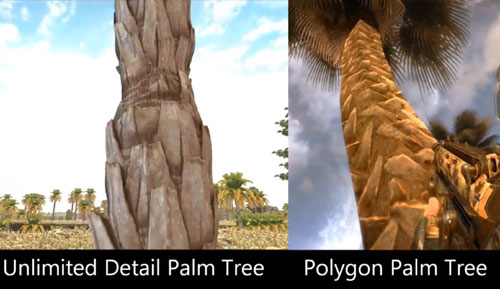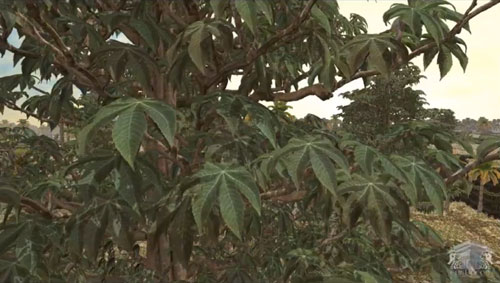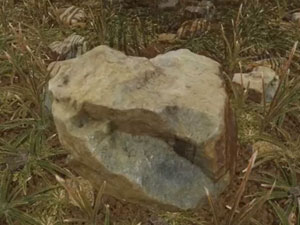[08:19 Wed,3.August 2011 by Thomas Richter] |

Computer-generated 3D graphics have an unlimited depth of detail and not based on the polygon model including textures but can represent the smallest building blocks (visual atoms) and so real objects almost perfectly digitally? That's the promise of Australia's nine-man software company Euclideon that already last year, its new revolutionary technology was demonstrated in a demo video that was announced but since nothing more, and disappeared were - all the interest, urgent questions and doubts that the demo video generated them notwithstanding.  In a new video is the "unlimited detail" baptized technique now presented in more detail and also explains something. Graphics are in the new model from point cloud data (each point is a so-called atom) to claim the seemingly without much processing power for each perspective and each perspective can be rendered to distance views. The following video is among others shown in comparisons with current games, what distinguishes the new technology of the (old) polygon graphics, which because of limitations (the tiresome polygon budget) by the available computing power with many tricks to work in order to circumvent these . Shown is a boulder that was acquired by 3D scanning, true to life as a nuclear model and is shown. Here are the very impressive demo: ° VY = 00gAbgBu8R4 To game developers (which are initially the primary audience for Euclideons technology) to switch to a new model to make them palatable, has developed a converter, which conventional polygonal models from common 3D modeling programs like 3DS Max or Maya converts to the new point cloud model. The intention of the developers of Euclideon also eliminate their previous drawback of being only a technician for expensive and nice looking graphics but 3D-Artists/Designer need to. These will be the latest design with the release of the SDK in a few months, better-looking demo scenarios and test whether the new technology is really as revolutionary as claimed and the limits of the new model are. In a new video is the "unlimited detail" baptized technique now presented in more detail and also explains something. Graphics are in the new model from point cloud data (each point is a so-called atom) to claim the seemingly without much processing power for each perspective and each perspective can be rendered to distance views. The following video is among others shown in comparisons with current games, what distinguishes the new technology of the (old) polygon graphics, which because of limitations (the tiresome polygon budget) by the available computing power with many tricks to work in order to circumvent these . Shown is a boulder that was acquired by 3D scanning, true to life as a nuclear model and is shown. Here are the very impressive demo: ° VY = 00gAbgBu8R4 To game developers (which are initially the primary audience for Euclideons technology) to switch to a new model to make them palatable, has developed a converter, which conventional polygonal models from common 3D modeling programs like 3DS Max or Maya converts to the new point cloud model. The intention of the developers of Euclideon also eliminate their previous drawback of being only a technician for expensive and nice looking graphics but 3D-Artists/Designer need to. These will be the latest design with the release of the SDK in a few months, better-looking demo scenarios and test whether the new technology is really as revolutionary as claimed and the limits of the new model are.  But many questions remain unanswered: how can the data sets are handled, to the point of objects which consist of as many data points are needed. The Euclideon president Bruce Robert Dell speaks in the video after all, a spatial resolution of 64 atoms (ie the smallest graphic unit) per cubic millimeter of the represented. Unlimited number of details is indeed describe an unlimited number of data these details. Euclideons basic technology is the basic organization and quickly find just the data you need. But even if a sophisticated algorithm selects only the data that are needed to show a current view (the most will always be hidden), must be indeed a very large data set of 3D information only scans before just for this perspective required data is retrieved.  Are shown in the demo (and their quality somewhat schmälernden) repetitive elements, only missing the image of 3D artists owed or systemic in nature to avoid large amounts of data object? And the computing power is necessary for the representation of such detailed scenes such as in the demo video? (PS: Whoever wants to can the detailed narration of the videos here read. Are shown in the demo (and their quality somewhat schmälernden) repetitive elements, only missing the image of 3D artists owed or systemic in nature to avoid large amounts of data object? And the computing power is necessary for the representation of such detailed scenes such as in the demo video? (PS: Whoever wants to can the detailed narration of the videos here read. deutsche Version dieser Seite: 3D-Revolution: Grafiken mit beliebiger Detailtiefe? |





